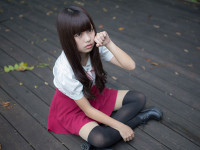Libgdx的使用(4)——舞台和演员
来源:互联网 发布:算法导论第三版中文版 编辑:程序博客网 时间:2024/06/11 02:25
本文使用的libgdx是0.92版本,和现在的最新版可能有一些不一样的地方。全文内容仅供参考。
我们先看几个游戏截图再来理解何为舞台。

请仔细观察图片中的元素,有些东西是不能动,有些可以动,有些有特效,有些没有。有些是按钮,有些是图片,但是其实它们都可以统一称为演员(Actor)。
而整个游戏界面就是我们的舞台。

再看一个射击类游戏






而其中的演员是
![]()
演员是游戏设计中常用的一个对象,它接受舞台的统一管理,拥有一些公共的事件,比如触摸,点击,但是同时还有自身的响应和属性。
而舞台就是容纳演员的场所。它统一管理所有演员,接受输入,同时提供一个方便的框架操作演员的时间变化。
我们来看一下Stage类:
它拥有一个Group,一个SpriteBatch,还有一个相机。
SpriteBatch我们在前几篇说过,这里就不再重复了。
Group是一个类,用于容纳和控制演员。但是这里要注意Group本身其实也是继承自Actor。
相机我们这里跳过,以后再说,可以暂时理解成一个控制观察视角和指标转化的工具。
当我们拥有一个演员后就可以调用addActor方法加入舞台。
舞台可以获取输入,但是需要设置。
下面来个列子,控制一个人物前进。

![]()
控制人物的按钮:

新建三个类:
FirstGame,实现接口ApplicationListener
FirstActor,继承Actor
NarrowButton,继承Actor
先看一下FirstGame
声明一个Stage,然后实例化FirstActor和NarrowButton,将二者加入舞台中,最后设置输入响应为Stage。
再看一下FirstActor。
声明一个Texture用于绘制。在构造方法中获取到高度和宽度,以便于后期的hit时间判断。
NarrowButton中代码绘制部分和上面的以下,主要是有个点击后控制人物行动的问题。
修改touchDown事件:
通过Group获取到FirstActor,控制x值。
到此为止一个最简单的人物控制我们已经实现了。但是这个有实例还有很多可以改进的地方,比如方向按钮没有点击效果,人物没有移动效果。
我们可以使用Animation来实现。添加一张图片

![]()
具体的原理我们看一下Animation类:
可以看出所谓的动画其实是一张一张的图片不断切换(其实所有的动画都是这个样子的)。
我们构造一个图片列表然后根据事件变动不停取出,重新绘制就形成动画了。
注意一下传入的时间和图片列表大小的问题,修改FirstActor代码如下:
效果:


这里注意一下,为什么我们要Texture转为TextureRegion。这是因为在实际开发中的图片是集成在一起的,比如所有角色要用的图片都是放在一张图里,然后分割截取的,对应的辅助方法TextureRegion.split。
另外我们可以发现NarrowButton和FirstActor中有大量代码重复了,可能有朋友觉得应该提取一下,其实libgdx已经帮我们做了,可以参考

我们先看几个游戏截图再来理解何为舞台。

请仔细观察图片中的元素,有些东西是不能动,有些可以动,有些有特效,有些没有。有些是按钮,有些是图片,但是其实它们都可以统一称为演员(Actor)。
而整个游戏界面就是我们的舞台。

再看一个射击类游戏
而其中的演员是
演员是游戏设计中常用的一个对象,它接受舞台的统一管理,拥有一些公共的事件,比如触摸,点击,但是同时还有自身的响应和属性。
而舞台就是容纳演员的场所。它统一管理所有演员,接受输入,同时提供一个方便的框架操作演员的时间变化。
我们来看一下Stage类:
pr otected final Group root;protected final SpriteBatch batch; protected Camera camera;
它拥有一个Group,一个SpriteBatch,还有一个相机。
SpriteBatch我们在前几篇说过,这里就不再重复了。
Group是一个类,用于容纳和控制演员。但是这里要注意Group本身其实也是继承自Actor。
相机我们这里跳过,以后再说,可以暂时理解成一个控制观察视角和指标转化的工具。
当我们拥有一个演员后就可以调用addActor方法加入舞台。
舞台可以获取输入,但是需要设置。
Gdx.input.setInputProcessor(stage);
下面来个列子,控制一个人物前进。
控制人物的按钮:

新建三个类:
FirstGame,实现接口ApplicationListener
FirstActor,继承Actor
NarrowButton,继承Actor
先看一下FirstGame
声明一个Stage,然后实例化FirstActor和NarrowButton,将二者加入舞台中,最后设置输入响应为Stage。
package com.cnblogs.htynkn.listener;import java.util.Date; import java.util.Random;import javax.microedition.khronos.opengles.GL;import android.util.Log;import com.badlogic.gdx.ApplicationListener; import com.badlogic.gdx.Gdx; import com.badlogic.gdx.graphics.GL10; import com.badlogic.gdx.graphics.g2d.BitmapFont; import com.badlogic.gdx.scenes.scene2d.Stage; import com.cnblogs.htynkn.domain.FirstActor; import com.cnblogs.htynkn.domain.NarrowButton;public class FirstGame implements ApplicationListener { private Stage stage; private FirstActor firstActor; private NarrowButton button; @Override public void create() { stage = new Stage(Gdx.graphics.getWidth(), Gdx.graphics.getHeight(), true); firstActor = new FirstActor("renwu"); button = new NarrowButton("narrow"); stage.addActor(firstActor); stage.addActor(button); Gdx.input.setInputProcessor(stage); } @Override public void dispose() { stage.dispose(); } @Override public void pause() { // TODO Auto-generated method stub } @Override public void render() { Gdx.gl.glClear(GL10.GL_COLOR_BUFFER_BIT); stage.act(Gdx.graphics.getDeltaTime()); stage.draw(); } @Override public void resize(int width, int height) { // TODO Auto-generated method stub } @Override public void resume() { // TODO Auto-generated method stub } }再看一下FirstActor。
声明一个Texture用于绘制。在构造方法中获取到高度和宽度,以便于后期的hit时间判断。
package com.cnblogs.htynkn.domain;import com.badlogic.gdx.Gdx; import com.badlogic.gdx.graphics.Texture; import com.badlogic.gdx.graphics.g2d.SpriteBatch; import com.badlogic.gdx.scenes.scene2d.Actor;public class FirstActor extends Actor { Texture texture; @Override public void draw(SpriteBatch batch, float parentAlpha) { batch.draw(texture, this.x, this.y); } @Override public Actor hit(float x, float y) { if (x > 0 && y > 0 && this.height > y && this.width > x) { return this; } else { return null; } } @Override public boolean touchDown(float x, float y, int pointer) { // TODO Auto-generated method stub return false; } @Override public void touchDragged(float x, float y, int pointer) { // TODO Auto-generated method stub } @Override public void touchUp(float x, float y, int pointer) { // TODO Auto-generated method stub } public FirstActor(String name) { super(name); texture = new Texture(Gdx.files.internal("actor1.gif")); this.height = texture.getHeight(); this.width = texture.getWidth(); } }NarrowButton中代码绘制部分和上面的以下,主要是有个点击后控制人物行动的问题。
修改touchDown事件:
通过Group获取到FirstActor,控制x值。
public boolean touchDown(float x, float y, int pointer) { Actor actor = this.parent.findActor("renwu"); actor.x += 10; return false; }效果:

到此为止一个最简单的人物控制我们已经实现了。但是这个有实例还有很多可以改进的地方,比如方向按钮没有点击效果,人物没有移动效果。
我们可以使用Animation来实现。添加一张图片
具体的原理我们看一下Animation类:
public class Animation { final TextureRegion[] keyFrames; public float frameDuration; /** Constructor, storing the frame duration and key frames. * * @param frameDuration the time between frames in seconds. * @param keyFrames the {@link TextureRegion}s representing the frames. */ public Animation (float frameDuration, List keyFrames) { this.frameDuration = frameDuration; this.keyFrames = new TextureRegion[keyFrames.size()]; for(int i = 0, n = keyFrames.size(); i < n; i++) { this.keyFrames[i] = (TextureRegion)keyFrames.get(i); } } /** Constructor, storing the frame duration and key frames. * * @param frameDuration the time between frames in seconds. * @param keyFrames the {@link TextureRegion}s representing the frames. */ public Animation (float frameDuration, TextureRegion... keyFrames) { this.frameDuration = frameDuration; this.keyFrames = keyFrames; } /** Returns a {@link TextureRegion} based on the so called state time. This is the amount of seconds an object has spent in the * state this Animation instance represents, e.g. running, jumping and so on. The mode specifies whether the animation is * looping or not. * @param stateTime the time spent in the state represented by this animation. * @param looping whether the animation is looping or not. * @return the TextureRegion representing the frame of animation for the given state time. */ public TextureRegion getKeyFrame (float stateTime, boolean looping) { int frameNumber = (int)(stateTime / frameDuration); if (!looping) { frameNumber = Math.min(keyFrames.length - 1, frameNumber); } else { frameNumber = frameNumber % keyFrames.length; } return keyFrames[frameNumber]; } }可以看出所谓的动画其实是一张一张的图片不断切换(其实所有的动画都是这个样子的)。
我们构造一个图片列表然后根据事件变动不停取出,重新绘制就形成动画了。
注意一下传入的时间和图片列表大小的问题,修改FirstActor代码如下:
package com.cnblogs.htynkn.domain;import com.badlogic.gdx.Gdx;import com.badlogic.gdx.graphics.Texture;import com.badlogic.gdx.graphics.g2d.Animation;import com.badlogic.gdx.graphics.g2d.SpriteBatch;import com.badlogic.gdx.graphics.g2d.TextureRegion;import com.badlogic.gdx.scenes.scene2d.Actor;public class FirstActor extends Actor {Texture texture1;Texture texture2;Animation animation;TextureRegion[] walksFrame;float stateTime;@Overridepublic void draw(SpriteBatch batch, float parentAlpha) {stateTime += Gdx.graphics.getDeltaTime();TextureRegion currentFrame = animation.getKeyFrame(stateTime, true);batch.draw(currentFrame, this.x, this.y);}@Overridepublic Actor hit(float x, float y) {Gdx.app.log("INFO", x + " " + this.width);if (x > 0 && y > 0 && this.height > y && this.width > x) {return this;} else {return null;}}@Overridepublic boolean touchDown(float x, float y, int pointer) {// TODO Auto-generated method stubreturn false;}@Overridepublic void touchDragged(float x, float y, int pointer) {// TODO Auto-generated method stub}@Overridepublic void touchUp(float x, float y, int pointer) {// TODO Auto-generated method stub}public FirstActor(String name) {super(name);texture1 = new Texture(Gdx.files.internal("actor1.gif"));texture2 = new Texture(Gdx.files.internal("actor2.gif"));this.height = texture1.getHeight();this.width = texture1.getWidth();TextureRegion region1;TextureRegion region2;region1 = new TextureRegion(texture1);region2 = new TextureRegion(texture2);walksFrame = new TextureRegion[30];for (int i = 0; i < 30; i++) {if (i % 2 == 0) {walksFrame[i] = region1;} else {walksFrame[i] = region2;}}animation = new Animation(0.25f, walksFrame);}}效果:

这里注意一下,为什么我们要Texture转为TextureRegion。这是因为在实际开发中的图片是集成在一起的,比如所有角色要用的图片都是放在一张图里,然后分割截取的,对应的辅助方法TextureRegion.split。
另外我们可以发现NarrowButton和FirstActor中有大量代码重复了,可能有朋友觉得应该提取一下,其实libgdx已经帮我们做了,可以参考

这里有一些常用的UI控件,估计下一篇可以讲到。
转载:http://www.huangyunkun.com/2011/11/15/libgdx_4/
0 0
- Libgdx的使用(4)——舞台和演员
- libgdx基本使用——舞台与演员
- android游戏开发框架libgdx的使用(四)--舞台和演员
- android游戏开发框架libgdx的使用(四)--舞台和演员
- Libgdx的使用(6)——演员和演出
- libGDX——舞台类的使用
- libgdx的基本使用——演员与演出
- libgdx游戏引擎(四)之舞台和演员
- Libgdx的使用(10)——双舞台
- (libgdx小结)演员类的使用
- android游戏开发框架libgdx的使用(十)—双舞台
- android游戏开发框架libgdx的使用(十)—双舞台
- LibGDX_4.4: 演员 与 舞台 的 事件处理
- Libgdx专题系列:对象篇 Stage舞台 Actor演员
- android游戏开发框架libgdx的使用(六)--演员和演出
- android游戏开发框架libgdx的使用(六)--演员和演出
- android游戏开发框架libgdx的使用(五)--舞台和常用UI类
- android游戏开发框架libgdx的使用(五)--舞台和常用UI类
- oracle学习之逻辑结构2
- 如果爱
- iPhone手机端越狱及修改hosts文件,在代码中根据域名进行访问ip
- java解压缩zip文件,java创建zip文件,java压缩文件,java解压文件,用到ant.jar解决汉字乱码
- 怎么使用Banner制作,现在来和大家分享一下
- Libgdx的使用(4)——舞台和演员
- ExtJs4 笔记(4) Ext.XTemplate 模板
- css中的background:transparent的作用
- 安装KVM
- zoj 2405 (专业的四位数字)(水水)
- php重定向后需要exit
- 理解RESTful架构
- 扩展jQuery EasyUI 的表单验证
- iOS- 打包


